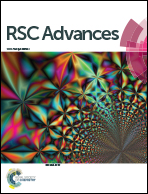Development of a superhydrophobic polybenzoxazine surface with self-cleaning and reversible water adhesion properties†
Abstract
A superhydrophobic polybenzoxazine surface has been developed by utilizing pendent aliphatic chain-substituted benzoxazine and TiO2. Surface wettabilities, and static and dynamic wettability, have been characterized by contact angle measurement. As a result, the prepared superhydrophobic polybenzoxazine/TiO2 film exhibits a static water contact angle of ∼163 ± 3° with a low water sliding angle of ∼1°, leading to self-cleaning properties. This superhydrophobic polybenzoxazine/TiO2 surface also has excellent resistance to solvents and corrosive liquids. Interestingly, this low-adhesive superhydrophobic surface switches to a high-adhesive surface when exposed to UV light and transfers to the initial low adhesion surface when heated. The mechanism of the smart switch has been studied by using FT-IR, XPS and AFM. TiO2 is responsible for the reversible water adhesion as it can absorb and desorb water molecules after UV irradiation and heat treatment. More importantly, along with the pendent aliphatic chains of polybenzoxazine, the surface maintains stable superhydrophobicity during the reversible switch.


 Please wait while we load your content...
Please wait while we load your content...